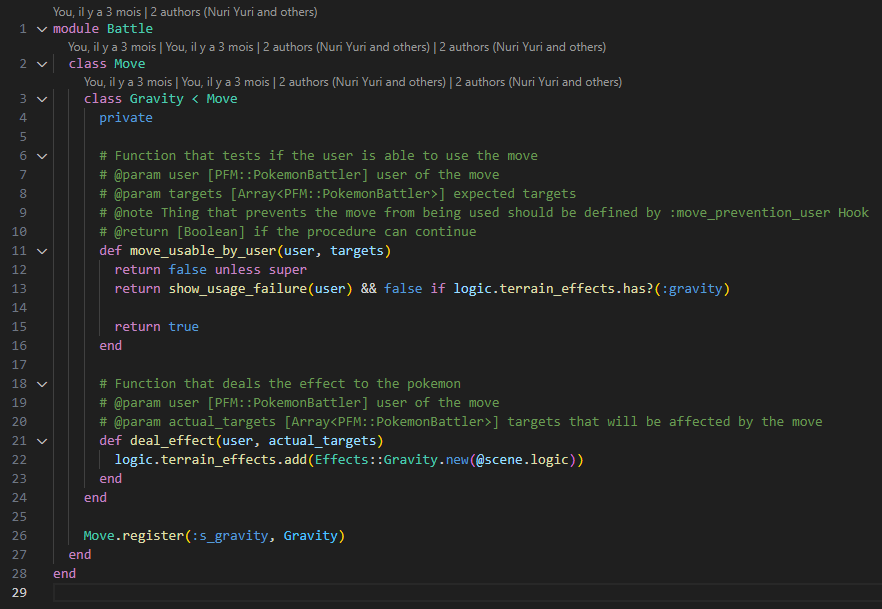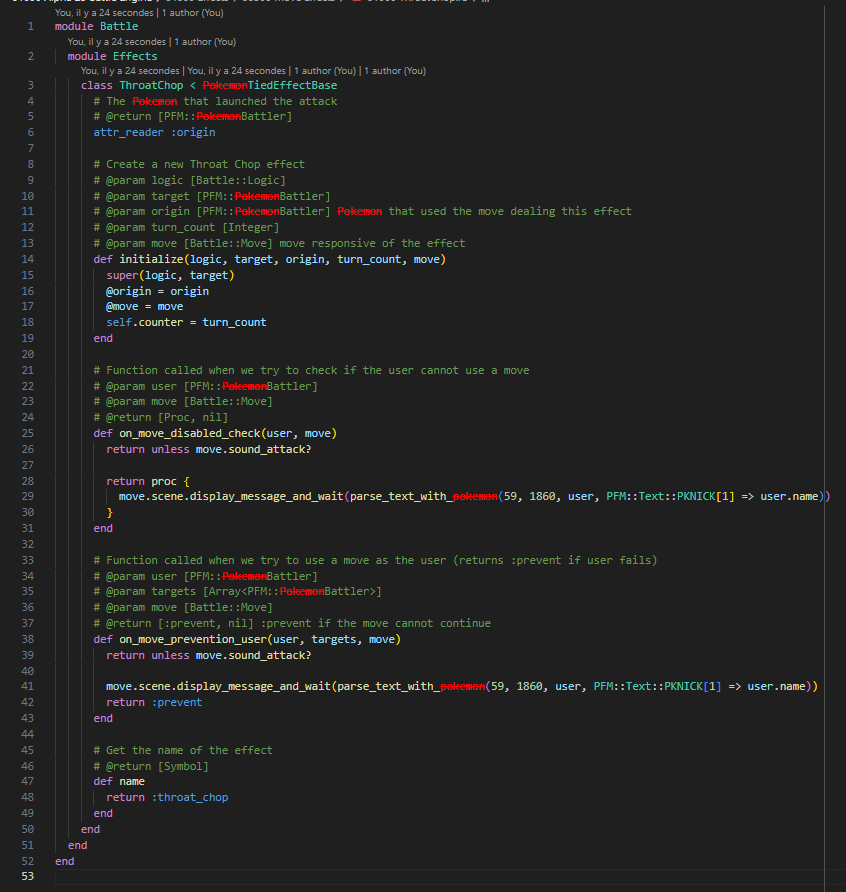How to fail a move ?
What are the ways to fail a move?
A move failure results from various factors. If a specific reason causes the move to fail, the concerned functions should return false rather than true. Within this returned false, the reason for the failure should be clearly indicated by a message.
From the code of the move itself
Some moves can fail due to their mechanics. For example, using Gravity in an area already under the effect of Gravity will cause the move to fail. To handle this, there is a method within moves: move_usable_by_user which should return false if the terrain is already under the effect of Gravity.
Example with "Gravity"

Note: If you wish to learn more about move_usable_by_user, please go to the section Understanding the move_usable_by_user function at the end of the article.
From the code of an effect
Effects expose a function that allows returning false when move_usable_by_user is invoked. This method is called on_move_prevention_user. Its operation is similar to move_usable_by_user: if you return false, then the move will fail. This is useful for creating effects (abilities, items, weathers, terrains, etc.) that will cause certain moves to fail.
Example with the effect of the move "Throat Chop"

Understanding the move_usable_by_user

What particularly interests us in this function :
exec_hooks(Move, :move_prevention_user, binding)
exec_hooks : This is a method that is called to execute a series of Hooks. Hooks are functions or procedures that are triggered in response to certain events or conditions in the program. They allow modifying the standard behavior of a function or adding additional functionalities without changing the original code of the function.
Move : This first argument specifies the context or scope of application of the Hooks to be executed. Here, Move indicates that the Hooks pertain to Pokémon abilities. Move represents the class that groups together the Hooks related to abilities.
:move_prevention_user : The second argument is a symbol that specifically identifies the Hooks to be executed. In this case, :move_prevention_user refers to a set of Hooks aimed at checking if the user Pokémon can perform a certain move. These Hooks can include checks for conditions like status effects, terrain effects, weather conditions, etc., which could cause the move to fail.
binding : The third argument, binding, is a bit more complex. In Ruby, a binding is an object that encapsulates the execution context of a piece of code, including local variables, available methods, the value of self, etc. Passing binding to exec_hooks thus allows the Hooks to access the context in which exec_hooks was called. This means they can read and modify local variables, call methods, and so on, as if they were part of the original code of the method move_prevention_user.
Understanding the procedure of the function move_prevention_user
Hook Call
When exechooks(Move, :move_prevention_user, binding) is executed, it searches for and executes all the Hooks associated with the event or condition :move_prevention_user in the context of moves (Move).
Management of the value returned by the Hook
If none of the executed Hooks raises a Hooks::ForceReturn exception, the function move_prevention_user continues its execution normally and reaches the return true at the end, indicating that the move will perform.
However, if a Hook decides that the move should not be used and returns false (either directly or via an exception such as Hooks::ForceReturn with e.data containing false), the execution flow of move_prevention_user is interrupted, and it returns false to its caller.
Consequences of returning false
The return of false means that something has prevented the selection of the move. This could be due to various game-specific reasons, such as field effects, abilities, items, etc...
The calling function or method that invoked move_prevention_user must then handle this false to decide on the subsequent actions. For example, this may result in displaying a message to the user indicating that the move failed.